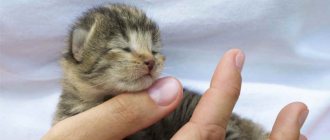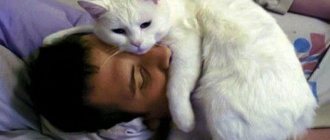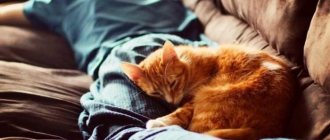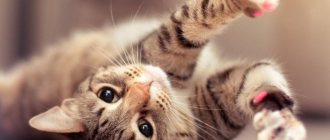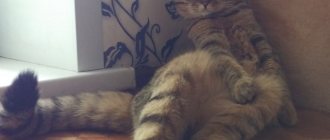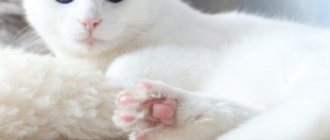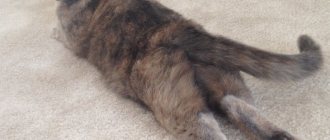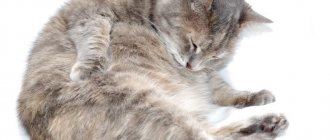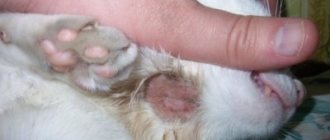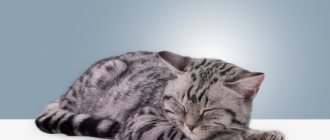Just because you and your cat speak different languages does not mean you cannot communicate successfully. People and cats have a special connection that has developed over centuries. Your cat can easily communicate its needs or mood to you using posture, tail movement, and gaze. You just need to be able to decipher these simple signals.
Cats are active and curious creatures. During the day they can make hundreds of different movements. But furry pets make some movements precisely in order to “say” something to their owner.
The cat sits with its paws tucked
You can see a cat in this position very often. This position of the cat’s body indicates that he feels cozy, comfortable and comfortable in the house. The animal is relaxed and just resting, dozing off. Paws tucked under the chest show that the cat is confident that she will not have to use her claws in the near future.
It is not advisable to disturb the cat at this moment. She will not show aggression, but she will not be happy with the owner’s intervention. It is worth picking up a cat sitting with its front paws tucked in only to, for example, carry it onto your lap and stroke it. The main thing is not to spoil the animal’s relaxed mood.
How cats talk to us
Cats and cats communicate with each other using body movements and smells, rarely using sounds. When we are around people, they notice that we respond better to their voice than to body language.
Cats communicate with each other using body language and smells.
Therefore, animals change their communication style to exploit human strengths and weaknesses.
Our pets view us as surrogate mothers and use their voices to tell us what they want. A little kitten, meowing, tells its mother that it feels bad. As adults, cats actively use this to communicate with people.
Types and meaning of cat talk
To express its emotions with its voice, a pet always pronounces exactly those sounds that are suitable for a given situation. They differ in strength and timbre (high or low). Any trouble is expressed by low sounds, and peace and pleasure are expressed by high sounds.
Meowing in the form of a long “meow” is a greeting to the owner who has returned home or a request, and sometimes a complaint. The short “me” means confusion or question. The goal of any “meow” is to attract the attention of others. If the owner does not respond to the first polite “meow”, the cat will ask more demandingly and loudly in order to achieve results.
Vowel sounds in different keys are a cat’s request:
- “I want to go outside”;
- “it’s time to eat”;
- "I'm upset";
- "I'm in pain."
A very loud cry from a cat is a sign of panic, a warning to owners about mortal danger in the event of a fire, earthquake or other disaster. Sometimes a pet mourns the death of a friend or moving to a new home with this cry.
Many owners have paid attention to “silent meowing,” when a cat, looking at a person, opens its mouth, but there is no sound. In fact, it exists, but in the ultrasonic range, which only animals can hear. But a person more often reacts to such a quiet “meow”, and the cat notices this and uses it with might and main.
Purring (special cooing sounds) shows the calm state of the cat, without aggression. He is happy with everything. Mother cats purr for kittens: everything is fine, there is no danger. This is how a pet shows its affection for its owner. He is happy when petted, purrs and squints his eyes. If he follows you around, tries to climb onto your lap, brings you a toy or food - this is also a sign of his love. When he rubs his head against your legs or “butts” his forehead, massages with his paws, licks your hand and sits next to you if you are sick - do not doubt that you are more important to him than anything in the world.
By purring, the cat shows that he is happy and loves you.
If dissatisfied, the cat purrs in low tones, warning that you are interfering in its affairs. Hisses when scared, but does not dare to attack. If he snorts and moves forward when meeting an enemy, he is ready for a fight. With a loud howl, he tries to break the enemy’s fighting spirit so that he retreats first.
Scientists have found that cats can produce hundreds of different sounds, and at least 15 of them are meows. Among them there are consonants: “g”, “v”, “f”, “r”, “m”, “n”. There is even a “Dictionary of Cat Language”, which includes more than 3 thousand “words” and “concepts” for different breeds of cats.
Cat body language and body language
In addition to sounds, cats communicate with each other and with people using gestures and different positions of their bodies. The main tools for expressing emotions are the tail, eyes and ears.
Body position indicates mood, and maximum anger and intimidation before a fight can be accompanied by a howl or growl
"Tail" emotions
Tail movements show a cat's mood:
- wagging the tip of the tail is a sign of curiosity or irritation, sometimes sadness;
- if the tail whips up and down quickly, there is strong excitement;
- the tip of the tail rotates - it will defend itself;
- a triumphantly raised tail signifies friendliness and joy;
- the tail is tucked between the hind legs when frightened;
- the tail is lowered and ruffled in case of danger.
Eyes and ears
With wide open eyes, the cat shows curiosity, looks straight ahead - ready for battle, and his pupils sharply constrict if he is angry. Half-closed eyes indicate peaceful relaxation.
When the cat is completely relaxed, he stretches and looks at the world with half-closed eyes.
You can tell by the position of the ears when the cat is scared and trying to threaten. In this case, they are pulled back and pressed against the head.
If during a game the cat is discouraged by what he sees and cannot find an explanation, this can be seen from the expression of his face
If the ears twitch nervously, this means irritation and readiness to fight back. Vertical - study.
Curiosity is indicated by wide eyes and erect ears.
If a cat is dozing with his eyes closed and his ears moving in different directions, this is a skillful pretense; in fact, he is listening carefully to your conversation.
Emotional mustache
When a cat is happy and calm, his whiskers cheerfully stick out in all directions. They twitch while tracking prey. If the cat is interested in something, they are directed forward. Tranquility is reflected by the mustache flowing freely on the sides of the head.
Cats are very resourceful. If your pet notices that a certain “meow” is working, he can try a new sound and gauge the reaction of others. Talking to a person about yourself is a sign of friendship and sympathy.
The cat comes to sleep at your feet
There is nothing strange or special about the fact that a cat comes to sleep at the feet of its owner. Fluffy pets generally love to sleep next to their owners. In this case, they feel safer. If a cat comes to sleep at your feet, this is a sign that she completely trusts you.
Novosibirsk scientists have developed a revolutionary replacement for one of the aircraft parts
Mother-in-law's tongue easily propagates from leaves: a very simple method
Urgant on why a woman should always be unpredictable (even in marriage)
Also, since the cat in this case does not lie down directly next to you, but at some distance, it means that she also wants to retain freedom of action. The animal lying at the feet can get up and go about its business at any time.
If your cat loves to sleep on your feet but never does the same with other family members, congratulations. You are the beloved owner of a furry pet.
Cat sleep norms
You can endlessly look at a burning fire, flowing water and... at a sleeping cat. Moreover, these cute fluffies are big fans of sleeping - anywhere and anytime. Our pets certainly don’t suffer from insomnia: they spend two-thirds of their lives sleeping.
Cats sleep two thirds of their lives
Sleep phases
In nature, all felines, without exception, are effective predators with very similar habits. Only their sizes differ significantly, and, accordingly, their prey. The lion hunts a large antelope, and the domestic cat hunts a small mouse; but both of them do it with complete dedication. The stages of hyperactivity and concentration should be replaced by complete relaxation; this is necessary for the animal to quickly restore the nervous system and physical fitness. And at the same time - in order to properly digest a satisfying meal.
All cats, regardless of their size, easily fall asleep even in the most inappropriate, from our point of view, situations. Well, we've eaten - now we can sleep; We played - it’s time to go to the sideline again. Having actively frolicked, little kittens fall asleep right where it overtook them.
Kittens fall asleep right on the spot after active play
Cats' sleep is very similar to humans - it consists of two main phases: rapid and slow (or slow wave) sleep. These phases alternate like beads in a rosary, but the speed of their “sorting” changes significantly with the age of the animal.
The state of REM sleep, as its name suggests, is filled with emotions and such vivid events that the cat’s heartbeat quickens, blood pressure jumps, and temperature rises. It is in the fast phase that cats dream. Empathizing with what is happening to her on the other side of reality, a cat can “talk” in her sleep, twitch convulsively, roll her eyes... But it is usually not easy for her to instantly return from dreams to reality.
This state is also called the REM phase (an analogue of the English abbreviation REM - rapid eye movement), which stands for “rapid eye movement”.
The rate at which sleep phases change changes with age
Such an active fast phase is necessarily replaced by a slow one - the animal needs to relax and rest at least a little. That’s when your cat truly becomes “plasticine”: he falls asleep in the most incredible positions and, even if you tie him in knots, he still won’t wake up - even for his favorite treat. All processes in the cat’s body slow down, the muscles become limp.
During the slow-wave sleep phase, all processes in the cat’s body slow down.
Video: cat sleeps in a hammock
Kittens sleep
Cat babies are born blind and deaf. Eating and sleeping under mother’s warm belly are the only events and joys of their life. But in these little ones, the fast phase predominates and accounts for up to 70 percent - to put it simply, they dream, and sleeping kittens experience a lot of emotions.
Even newborn kittens dream
Even just yesterday, kittens that were born are happy about something and are afraid of something in their dreams - they twitch their paws, squeak, even hiss, opening their toothless mouths.
Newborn kittens sleep almost 24 hours a day and are only awake when they eat. This is completely normal, because all children grow well in their sleep. But the kids have already grown up, and the world of their interests is expanding every day further and further beyond the “nest” in which they were born. Kittens play a lot and actively, receiving a lot of impressions every minute, and proper rest is vital for them.
All cats love to sleep with their owners - even the smallest ones
In a dream, a kitten not only regains its strength, its brain works tirelessly - systematizes and analyzes the information received, puts all recent events “on the shelves.” As the baby grows up, it gradually enters an adult sleep pattern and by four to five months sleeps as much as its mother.
Sleep phases in adult animals
The older the animal, the less time it sleeps in the REM phase. The state of a sleeping cat becomes more calm and stable with age. Elderly cats can sleep peacefully for most of the day, not forgetting to keep their ears on top of their heads: what’s going on in the kitchen - is there tasty food spilling into the bowl?
The older the animals, the more peacefully they sleep
Domestic cats are among the top three “prize-winners” among mammals that are particularly fond of sleeping. Only possums and mice are ahead of them in this addiction. And bears, by the way, sleep significantly less in total, even taking into account the time they spend in hibernation.
Video: how cats sleep
Differences in sleep depending on breed
Breed characteristics, character and temperament are also reflected in cat dreams. Of course, homeless “noblewomen”, forced to earn their own food, would also not mind sleeping all day - but who will give it to them? Such animals have to stay awake for at least five hours a day.
Another thing is well-fed domestic lazy people, not even necessarily very thoroughbred. “Indoor” pets, especially if they are sterilized, are able to sleep almost the entire day - up to 22 hours a day!
Of course, every cat is a bright individual, but different breeds also have different attitudes towards sleep:
- The leaders in the Dormouse ranking are the imposing, handsome Persians - ambitious and narcissistic cats are very lazy and phlegmatic in everyday life;
Persian cats are big fans of taking a nap at their owner’s feet.
- Many British, Burmese and American shorthair cats are distinguished by sanguine balance - they sleep “according to circumstances” and in moderation;
- Representatives of such aggressive and even dangerous breeds as jungle and Siamese cats cannot afford to sleep for too long - almost all the time they are tense and ready to attack, and relax only for a short time;
- and the cute bald ones stand out completely apart: hairless sphinxes, Devon Rex, Ukrainian Levkoy and other devoted and affectionate cats constantly need warmth and care - they are ready to sleep as much as they want, but only next to their beloved owner; the rest of the time, animals can show unusual activity, and when carried away, completely forget about sleep.
Hairless cats are actively awake and fast asleep
Video: why cats sleep a lot
The cat sleeps curled up
Cats curl up when they want to keep warm. This does not mean that the cat is cold in the room and is experiencing discomfort. In fact, the animal just wants to be warmer and more comfortable while sleeping. This position is the same as covering a person with a blanket while sleeping.
Biology has overtaken physics: which elective subjects of the Unified State Exam are popular this year
It turns out that a person is able to answer questions in a dream: new research
Israel plans to open soon: the best places to visit in this country
What do different cat sleeping positions mean?
The journal Neuroscience & Biobehavioral Reviews states that lethargy and depression are the most common symptoms of the disease. If your cat withdraws and sleeps more, she may be trying to hide pain or illness.
Observe your cat as it sleeps, as the posture your cat adopts can reveal the source of its discomfort. Sleep positions are a useful barometer of health when considered in conjunction with other physical symptoms.
The table below details common sleep positions in sick cats and what they may mean:
A cat curled up in a ball is a common sight during the colder months. In this position, the cat remains comfortable.
Low body temperature
As science explains, cats lose heat through their food and paw pads while they sleep. This position protects these limbs.
If you find your cat in this position, check the ambient temperature. To keep cats comfortable, the room temperature should be around 70 degrees Fahrenheit. If necessary, install additional heat sources on the cat's bed.
If a cat's body temperature drops below 100 degrees Fahrenheit, she is at risk of hypothermia. Do not check your cat's temperature while sleeping. Diseases that lead to a decrease in body temperature in cats include:
- respiratory infections
- Shock
- Consuming toxins
- Heart failure
The cat is sitting, looking at something unknown
Some people believe that cats can see otherworldly things. In reality this is, of course, not the case. Cats have very acute vision. They see better than humans. And the cat may just be looking at some midge that you don’t notice.
Giraffes have no problems with blood pressure: the long-necked gene will help people with hypertension
Using a radio telescope, astronomers looked at the “cosmic jellyfish” for the first time
Products are fermented: culinary tricks of the peoples of the world for a beautiful figure
What does a cat's sleeping position mean?
It is known that cats spend 70% of their lives sleeping - which is why sleep is so important in the lives of these animals. There are several reasons why they sleep so much: for example, it helps cats properly digest the protein foods on which their nutrition is based. In addition, pets do not always sleep soundly.
Every cat has a favorite sleeping position. Did you know that it helps you learn more about your pet's well-being and thoughts? Today we will tell you the meaning of the position of an animal in a dream.
The cat is frightened by sudden movements of the owner and runs away
Sometimes it happens that a cat shows love and trust to its owners, but with sudden movements, for example, if the owner quickly gets up from a chair or waves his hand in a conversation, he gets scared and runs away. Fostered outdoor cats or animals that were abused by their previous families often behave this way.
NASA spotted a snake-like exoplanet with its own atmosphere
The greatest comedian of all time: what happened to the 3 sons of Louis de Funes
What does Sergei Yursky's daughter do: she looks very much like him (new photos)
If your cat behaves this way, try to calm him down by petting him and holding him in your lap. Over time, the animal will no longer be afraid of your sudden movements.
In addition to the characteristic posture, signs of a concussion may include:
The set of symptoms depends on the severity of the injury and the location where it occurred.
It should be remembered that even a mild concussion causes quite extensive damage.
Brain tissue suffers not only at the site of impact, but also on the opposite side, because the brain, not fixed, but floating in the brain fluid inside the skull, is sharply deflected by inertia and hits the other wall of the skull.
Having made a diagnosis, doctors usually prescribe vascular agents to prevent edema, as well as painkillers, antiemetics, sedatives, and, if necessary, medications to support the functioning of the lungs and heart.
In conclusion, we will say that in addition to a concussion, the cause of headaches and dizziness that causes a cat to rest its head against the wall can be acute toxic conditions, that is, poisoning, diseases of the nervous system, tumors of the brain or spinal cord, and some other conditions.
Source
Cat's tail tongue: tail held high
The easiest way to guess a cat's intentions and mood is by observing its tail. If a cat walks around the house with its tail held high, it expresses confidence and satisfaction. The cat is happy and ready to make friends and communicate with all the people in the house. If the tip of the cat's tail twitches a little at the same time, it means that she is especially happy with life.
At this moment it is worth playing with the cat. She is in an extremely good mood and you should definitely take advantage of it.
Why cats lie on their backs but don't sleep
Before directly analyzing the situation, it is important to verify the fact of the dream. If the cat is lying on its back, but is awake, then its position will be explained by completely different reasons.
Defend against attack
Despite the vulnerability of the tummy, in a certain position its demonstration becomes part of a defensive posture. If the cat feels uneasy around other pets or strangers who have come to visit, then it can lie on its back with its claws extended. From this position it is convenient to attack with paws and teeth.
playing
When in a playful mood, cats often roll from side to side, trying to grab something with their paws. In this way they demonstrate the hunting instinct, so you should not touch the belly with your bare hands or feet.
Instead, it is recommended to throw a toy mouse, ball or plush toy into your pet's paws. After that, he will happily begin to bite her and kick her with his hind legs.
Attract attention
Cats are famous manipulators. They quickly remember the habits and reactions of their owners to certain actions. What causes delight and tenderness is noticed with particular interest: meowing in response to human speech, a plaintive look, graceful stretching and demonstration of a fluffy belly. Pets skillfully use all this to extort treats and attention to themselves.
“ If your cat is in the mood for affection and demonstrates good nature with her entire appearance, then do not wait for her to change her mind and take advantage of the moment.
Overate
Inactive neutered pets are most prone to overeating. To avoid obesity, their diet must be constantly monitored. If you do not comply with the daily caloric intake and feed your pet out of pity, then he may have serious digestive problems.
Frequent overeating slows down the digestion of food. Its excess accumulates in the stomach and stretches its walls, causing pain and heaviness. Trying to eliminate the discomfort, the cat lies on its back and tucks its paws. This position reduces pressure on the stomach that is overloaded with food.
Cats in heat
At puberty, cats begin to loudly call for the cat, raise the back of their body and roll on the floor on their back. There is no point in scolding your pet for night concerts. Estrus is a natural process that encourages an animal to take certain actions, regardless of desires.
Behavior can deteriorate for the worse even in the most obedient mustaches. Try to be patient and be sure to sterilize your pet if you do not plan to breed kittens.
A similar problem can bother the male. During sexual hunting, discomfort occurs in the groin due to increasing arousal. It is unrealistic to satisfy him without mating, but it is quite possible to weaken the sensations. This is facilitated by the position with the belly up. Despite its effectiveness, here it is also better to turn to castration, since it gives not a temporary, but a permanent result.
Big belly bothers me
This problem occurs not only in overfed animals, but also in frankly fat ones, as well as pregnant women. In the latter case, kittens increase the load on internal organs. They make it difficult for the mother to breathe, so the only comfortable position is lying on her back.
INTERESTING!
Separating kittens from their mother too early affects their sleeping position. Such babies grow up less confident and very rarely show their belly.
Why do cats hide?
Cats are excellent hunters and are good at hiding. Of course, the owner may think that the cat doing this simply wants to play hide and seek. But in reality there can be many reasons for this behavior.
Although cats are predators, in many cases they try to avoid confrontation. When frightened, the animal will most likely run away and hide. By retreating in this way, the cat gives itself space to maneuver, a subsequent possible attack and fight for the purpose of defense.
Cats can also hide if they have just arrived in a new home. The same behavior is often observed in cats when the owners suddenly change something in the house. For example, they bring new furniture or rearrange old ones. A new stranger appearing in the house can also cause a similar reaction.
Why does a cat rest its head against the wall when sleeping?
Sometimes, for no apparent reason, your pet suddenly changes its daily behavior. The owner should be wary - this may be a sign of a disease that can only be diagnosed by a veterinarian. Before going to the clinic, you should take a closer look at the cat. Immediately go to the doctor if she refuses food and drink, reacts painfully to being touched or picked up, her breathing rhythm changes, her fur is tousled, does not fit correctly to her body, the cat takes unnatural positions when walking, sitting or lying down. All this is a sign of several diseases, including inflammatory processes of internal organs, poisoning, serious injuries (falling from a height, beating, etc.). Unnatural behavior and posture may not be associated with any disease. The fact is that the behavior of an animal is changeable, due to age, biological characteristics (readiness for fertilization, childbirth, etc.), ethology (the natural disposition and habits of the animal are determined), and the lifestyle of the owners themselves. Pets adapt to certain living conditions based on personal experience. Also, it has been scientifically proven that animals are susceptible to changes in the electromagnetic field of the Earth, therefore the behavior in which it rushes around the territory (house, yard, etc.), and then suddenly calms down, huddled somewhere (lasts about 24-48 hours) - indicates the likelihood of a natural disaster or earthquake within a radius of 100-150 km from the epicenter. The owner should be alarmed by the appearance of the symptoms listed at the beginning of the article. If a cat behaves unnaturally, takes positions that are unusual for it, first of all, this is a sign of illness or injury. Any slightest change in the behavior of a pet that is not inherent in its lifestyle in a healthy state is already a signal for immediate observation, a step towards qualified consultation.
Possible reasons for behavioral changes
The owner notices the fall (beating) of the animal as soon as possible. Symptoms: stops actively moving (even to the point of lying in one position for a long time), unable to approach food, water (or cannot take the correct position for eating); meows pitifully (especially if touched or lifted), lethargic, breathes heavily; signs of mechanical damage are visible on the body (blood, bumps, dislocations, limping, etc.). To avoid consequences from bruises and fractures, you should immediately show your cat to a veterinarian. Symptoms of tetanus: sudden short-lived (clonic) convulsions, when after each muscle contraction there is a relaxation; Coordination is impaired, it is difficult to open the jaw, etc. There may be tonic spasms: the muscles are in a state of contraction-relaxation for a long time, and the animal’s body seems to become stiff. Similar abnormal behavior also occurs with other infectious, viral, bacterial diseases (including toxicosis from the presence of helminths), or with pathology of systems in the cat’s body. Symptoms that occur with rabies: excessive affection of the pet is sharply replaced by aggression; can throw itself at inanimate objects (things, trees, fences); swallows inedible objects; aggressiveness towards other living beings (people, animals), increased salivation. The second stage of rabies is characterized by photophobia and hydrophobia (hides into darker places, is afraid to drink), excessive timidity, convulsive movements are observed (as if catching flies with its teeth), prolonged meowing (similar to howling or other sounds that are not characteristic of a cat). Inflammatory processes in the animal’s body and poisoning are the most difficult to diagnose for the owner. An exacerbation of the disease is easier to notice, since the pet’s behavior suddenly takes on an unnatural form: changes in temperature, attacks of pain are accompanied by an angry hissing (even growling), loud meowing, the cat takes unnatural positions in order to lie down and ease the pain in a certain area; Neuralgic attacks occur (convulsions, throwing the head back, etc.); nervousness (throwing around, frequent licking), the gaze becomes glassy, as if going nowhere. In the chronic course of the disease, the animal becomes apathetic, refuses to eat, stops caring for itself, refuses to go for walks, etc. Other reasons for unnatural behavior: changes in gait, reluctance to move, may indicate an accidental injury while walking. If a cat is constantly on its feet, refuses to lie down or sit down, it may have chest and stomach pain. There are a lot of reasons, ranging from bruises to intestinal obstruction. In any case, even if you know the reason for unnatural behavior or posture, consult a specialist. Your pet will be grateful for the speed of assistance provided for a quick recovery. Dear readers, this article is not a tutorial or instructions for self-treatment of cats. The animal needs the help of a specialist, because only in a clinical setting, based on research, using appropriate equipment, will the diagnosis be correctly established. Any delay or unqualified treatment can cost your pet’s life. Take care of your pet's health.
Source
Treat your pet yourself
As soon as an animal gets sick, the owners themselves try to make a diagnosis and prescribe therapy. They themselves select medications for them, folk remedies, or give them “human” drugs. It is important to understand that a diagnosis can only be made by a doctor and if tests have been completed. Accordingly, therapy is also selected by a specialist. If the medicine is intended for people, then only a specialist can tell you the correct dosage. In addition, animals should be brought for preventive examinations. And don’t ignore visiting a veterinarian-dentist.

